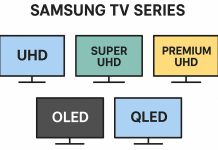Artificial intelligence (AI) in modern TVs and smartphones has become a key element of marketing campaigns, often portrayed as a revolutionary breakthrough. In practice, however, the actual capabilities of these technologies are frequently overstated. Most devices do not contain genuine AI in the full sense of the word. What is commonly referred to as “intelligence” is typically the result of software algorithms and the power of remote servers working together to optimize user experience.
AI in Smartphones: Convenience Without True Intelligence
In smartphones, AI is most noticeable in photography, where it enhances image quality, adjusts camera settings, and processes photos in real time. However, this is not the work of a sentient system — just well-designed image processing tools. Occasionally, photos may be sent to the company’s servers for more complex processing, but that’s still a technical operation, not intelligence.
Voice assistants like Siri or Google Assistant give the illusion of smart interaction, but they function by sending voice data to remote servers where the actual AI operates. The phone simply serves as an interface.
Other so-called “AI” features include performance optimization, which allocates resources to frequently used apps and conserves battery life. These functions, while useful, have existed for years and rely on behavioral patterns rather than learning.
Security tools such as facial or fingerprint recognition use standard recognition algorithms. Content personalization — such as app or media recommendations — is based on simple user data analysis. These features are smart, but not truly intelligent.
AI in TVs: Bold Claims, Basic Algorithms
In televisions, the term “AI” is even more heavily used in marketing. Brands boast of AI processors, yet most functions are based on pre-set rules and algorithms.
Image enhancement, like adjusting brightness or contrast based on lighting or content, is handled by templates rather than any adaptive intelligence. The same applies to sound processing, where audio is tuned for dialogue clarity or acoustic conditions.
Content recommendations are generated from viewing history — a result of pattern analysis, not decision-making by an intelligent system. Voice control, often cited as an AI function, works similarly to smartphones: the TV receives a command and passes it to a server-based assistant like Alexa or Google Assistant. It doesn’t interpret or decide anything on its own.
Where Technology Ends and Marketing Begins
While AI elements do exist in modern devices, they are typically limited to narrow, predefined tasks. They do not evolve, make decisions, or learn independently. Most so-called “AI” features are adaptive tools or algorithms created to enhance user convenience, not true artificial intelligence.
Manufacturers often label these features as “AI” to promote innovation and gain a competitive edge. But behind the buzzwords lies conventional software engineering — effective and clever, but not magical.
In conclusion, AI in smartphones and TVs is not a miracle breakthrough. It’s a collection of helpful technologies designed to improve user interaction. The perception of AI as something autonomous or transformative is more the result of marketing than reality.






